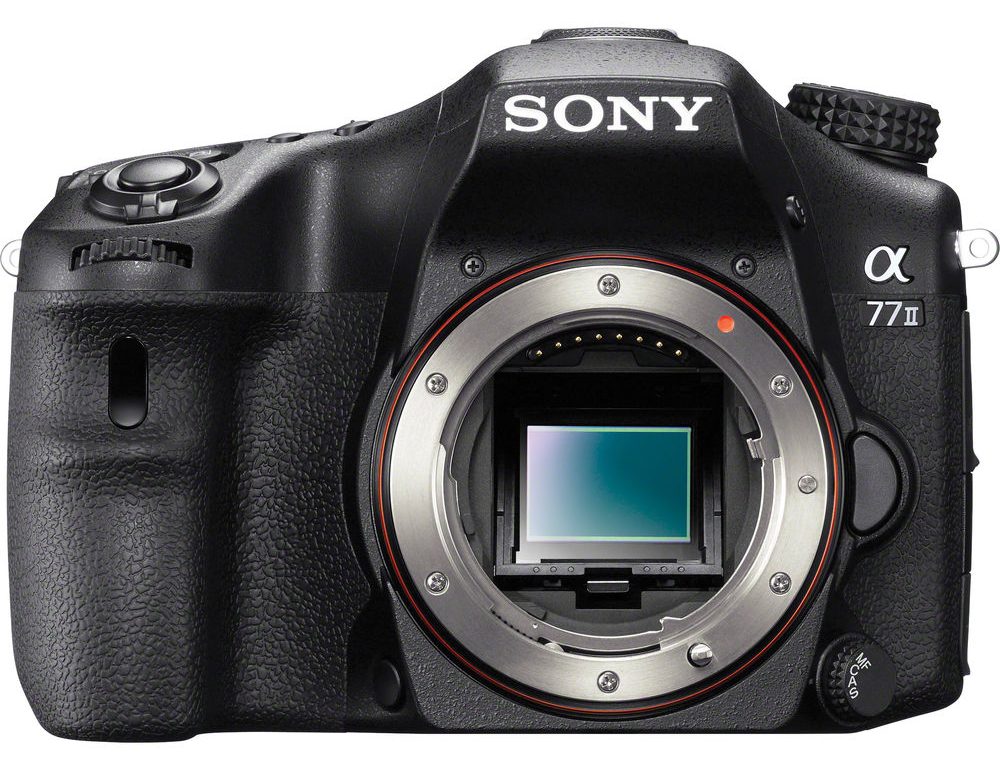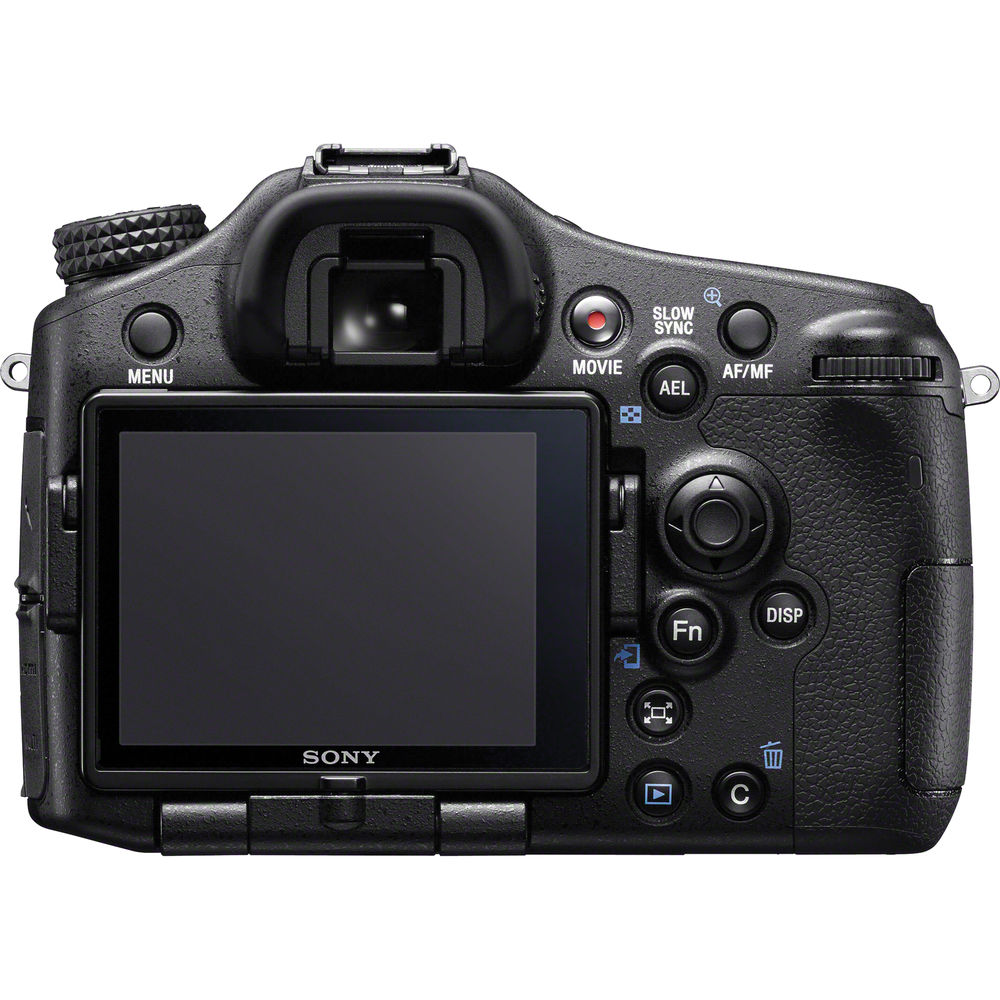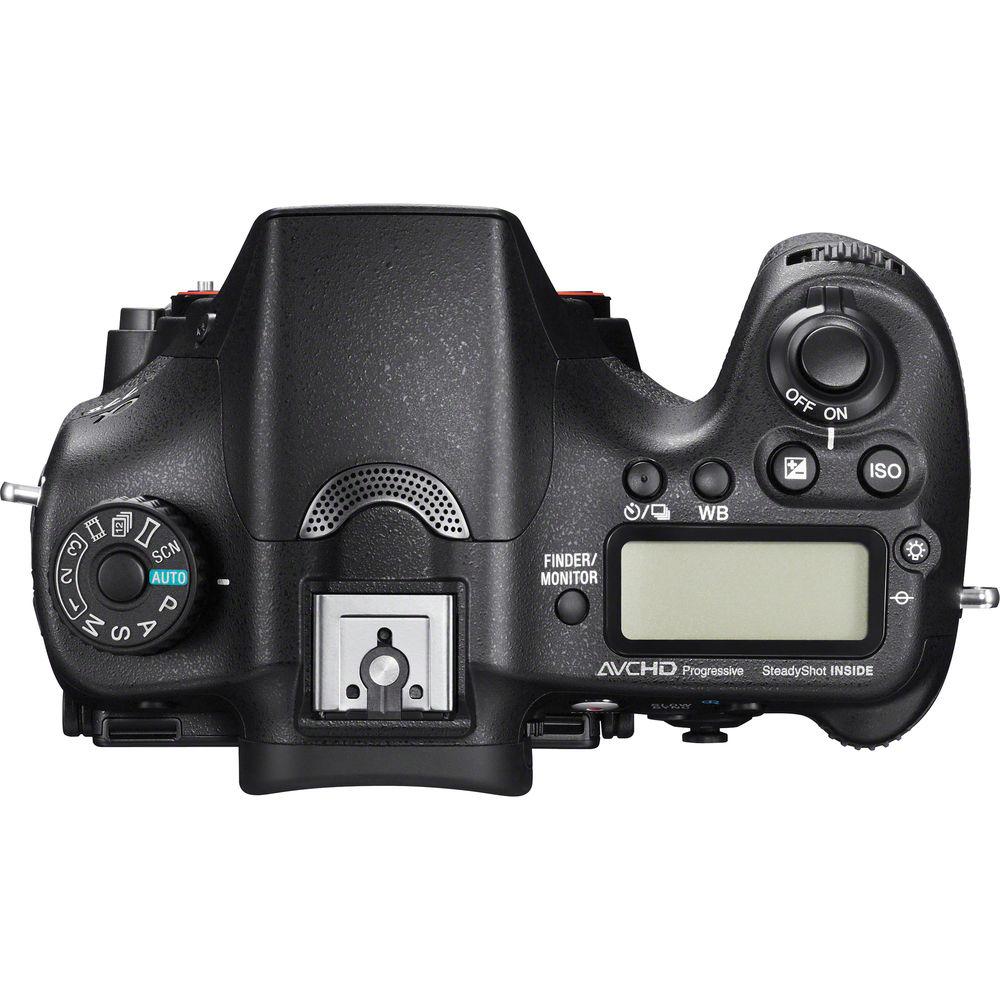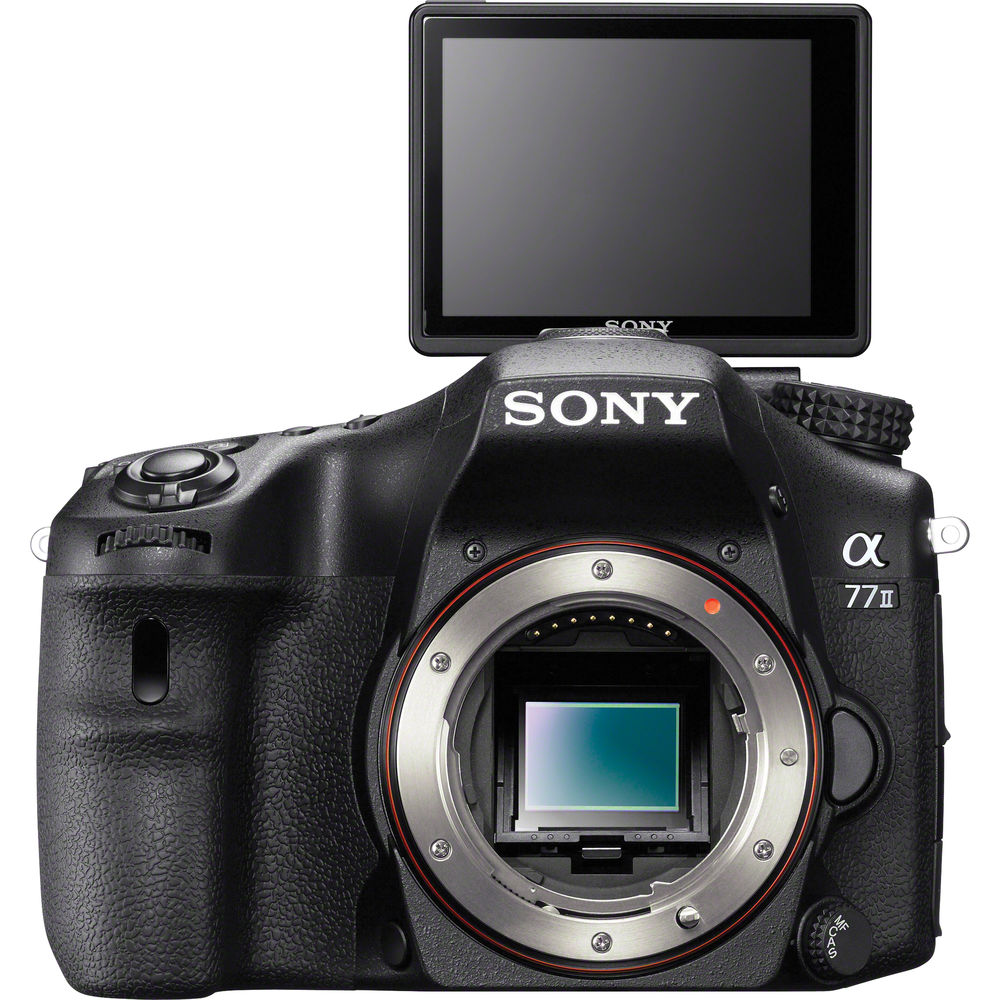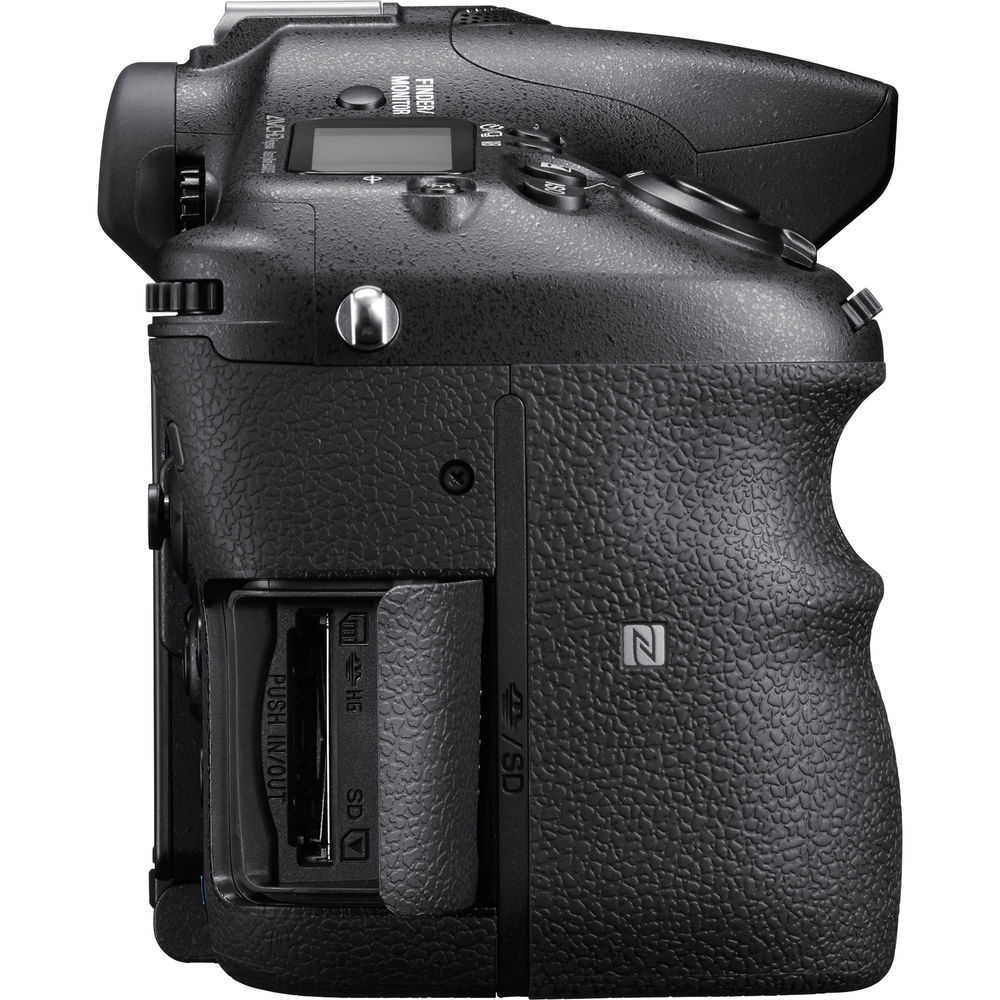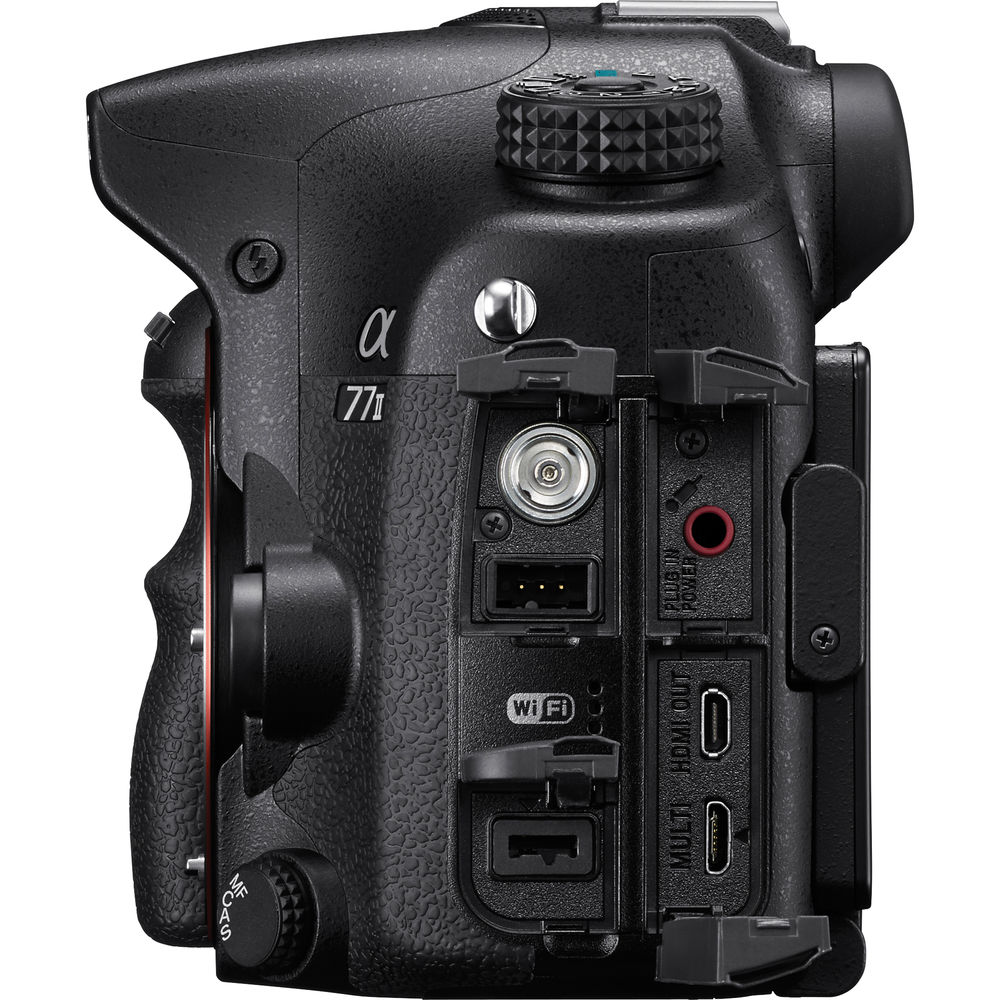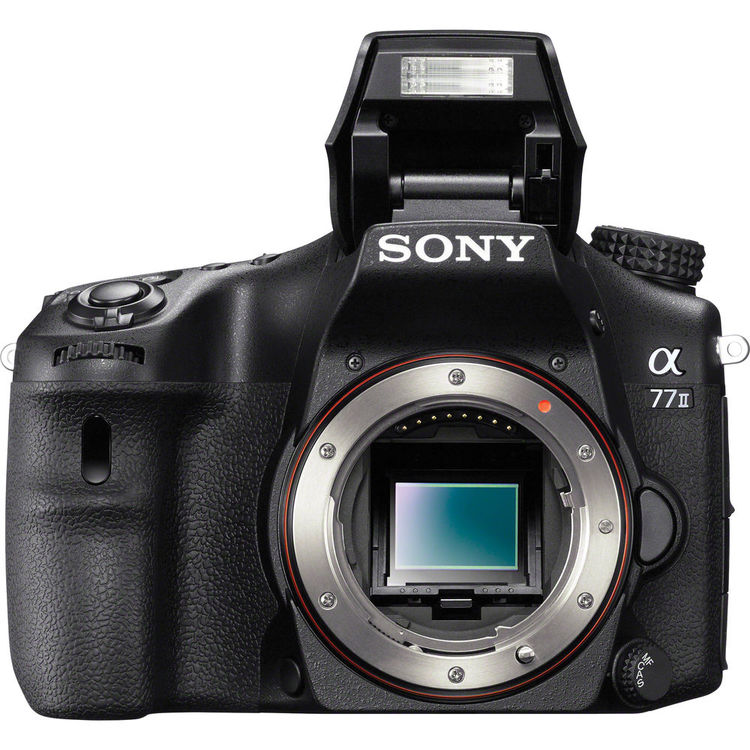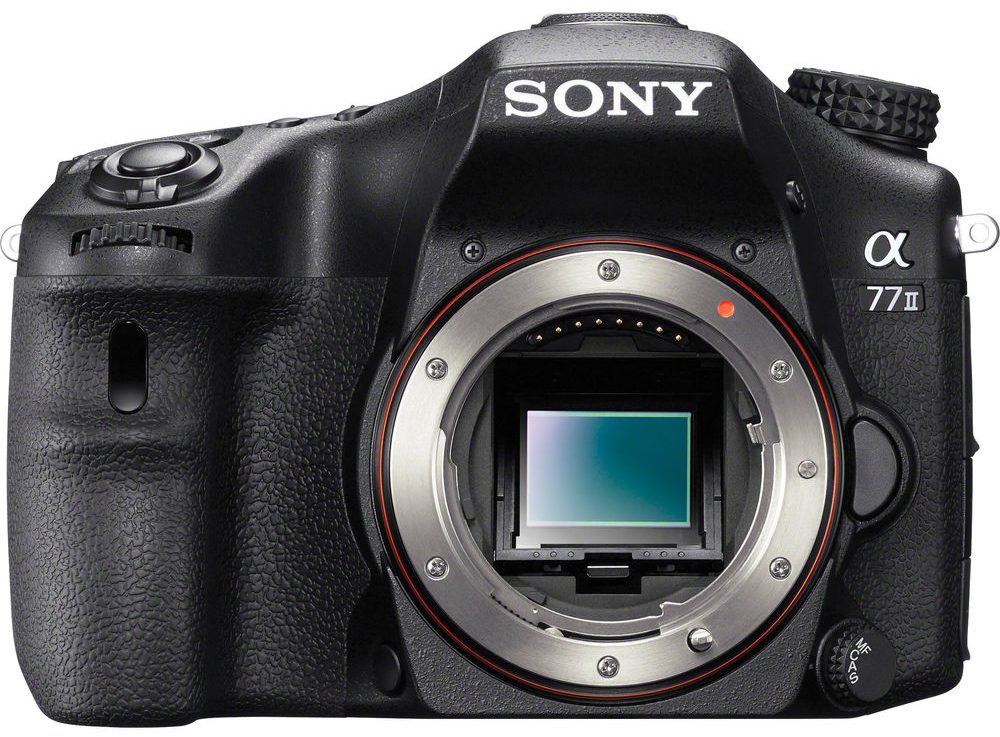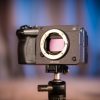Sony announced the Alpha A77 II DSLR yesterday and it looks liked a refined A77 with all new internals for the most part. New 24mp gapless sensor design, insane 79 point AF system w/ translucent mirror technology, New Bionz X processor, Huge 60 frame buffer (26 Raw), 12 fps, ISO 25600, and a fully articulating high res lcd screen.
The Sony a77II DSLR Camera is really packing some pro like numbers in the af department and buffer size, so this camera should be appealing to many photographers including, hard core enthusiasts, Semiprofessional, and even professional! If you are a motocross track shooter, this camera might be perfect for the extra crop factor zoom 1.5x x the focal length. I know the full frame is great, but 2oomm is often not enough and a 100-400mm style lens is required. With the 1.5x sensor crop factor, 200mm becomes ~300mm effectively, and this is very helpful in the larger field sports, the zoo, or anything that requires more reach. The longer lenses are very expensive for the full frame sensor coverage, so the crop factor cameras can save some serious cash in the huge lens department. Clearly full frame has better IQ and if you can afford it, by all means, but the crop factor does have some advantages in reach if you were not aware 😉
Key Features:
- 24.3MP APS-C Exmor CMOS Sensor
- BIONZ X Image Processor
- Gapless On-Chip Lens Design
- Translucent Mirror Technology
- 3.0″ 1,228k-Dot 3-Way Tilting LCD Screen
- 0.5″ 2,359k-Dot XGA OLED Tru-Finder
- Full HD 1080p Video Recording at 60 fps
- 79-Point Phase-Detection AF System
- ISO 25600 and Shooting Up to 12 fps
- Built-In Wi-Fi Connectivity with NFC
- Weight = 1.60 lb / 725.74 g (Body with Battery and Memory)
- Price = $1198 US @ BHPhoto | Amazon
- My Reviews >>
A77 II Camera Body Photos
Sony A77 II – Features and Specs
Features Breakdown courtesy of BHPhoto:
The Sony Alpha a77 II DSLR Camera is a versatile and advanced digital camera featuring a 24.3MP APS-C-sized Exmor CMOS sensor and BIONZ X image processor to produce high-resolution still images and Full HD movies with marked low-light quality and sensitivity to ISO 25600. Beyond notable imaging traits, the image processor also lends itself to continuous shooting up to 12 fps for up to 26 RAW frames. The processor and sensor combination are also significantly benefitted by the unique Translucent Mirror Technology, which effectively directs light to both the image sensor and focus sensor simultaneously. This enables the expansive 79-point AF system, which includes 15 cross-type points, to work continuously even while recording video and photographing in a continuous shooting mode.
For live view monitoring, image playback, and menu navigation, both a large rear monitor and detailed electronic viewfinder are available. The 3.0″ 1,228k-dot LCD screen features a three-way tilting design to facilitate easier use from both high and low angles and also incorporates WhiteMagic technology for easier viewing in bright conditions. The 0.5″ 2.359k-dot Tru-Finder OLED EVF offers 100% frame coverage and a refined optical design to provide a natural viewing perspective and magnification. The dust- and moisture-sealed magnesium alloy body also houses a configurable user interface, built around several customizable buttons and control dials, for efficient and intuitive access to frequently used camera settings. Additionally, a Multi-Interface shoe is available for attaching external flashes, lights, or microphones.
Built-in Wi-Fi connectivity, with support for NFC-enabled devices, is also integrated into the a77 II to support remote camera control and image sharing to linked mobile devices.
24.3MP APS-C Exmor Sensor and BIONZ X Image Processor
The 24.3MP APS-C-sized Exmor APS HD CMOS sensor and BIONZ X image processor work together to produce high resolution, well-detailed imagery with minimal noise and notable low-light quality and sensitivity to ISO 25600. The sensor utilizes a gapless on-chip lens design, which fills the gaps between neighboring pixels with optimized lenses that match the angle of incidence to increase light gathering ability and produce edge-to-edge sharpness and quality. Detail reproduction technology works to increase the fine detail rendering capabilities for a more three-dimensional, realistic image quality while diffraction-reducing technology helps to enhance the optical qualities of any lens by suppressing diffraction that is common when working at smaller apertures.
The BIONZ X processor also contributes to providing a wealth of speed throughout the camera system, including a top continuous shooting rate of 12 fps for up to 26 RAW frames and Full HD 1080i/p video recording in multiple frame rates.
Translucent Mirror Technology
Translucent Mirror Technology is a unique design that enables the mirror to continuously direct light to both image and autofocus sensors to provide continuous phase- and contrast-detection focusing for quick and precise performance. The additional speed afforded to the camera by eliminating the need for a swinging mirror benefits many shooting features including the fast continuous shooting rate, continuous focusing when shooting movies and working in continuous shooting modes, and also allows for the use of a high resolution electronic viewfinder for eye-level live view monitoring.
79-Point Wide-Coverage AF System
Complementing the imaging abilities, an equally apt phase-detection autofocus system, coupled with the Translucent Mirror Technology, provides fast and full-time continuous focusing performance to suit working in nearly any environment, even in lighting conditions as dim as -2 EV. Subject tracking is benefitted by the expansive 79 AF point array, which incorporates 15 centrally-located cross-type points for added precision in the most frequently used portion of the image frame. A centrally-located horizontal f/2.8 AF point is also incorporated within this array, and overlaps another AF point, to better support the use of large-aperture lenses. Also benefitting subject tracking, an enhanced flexible spot function utilizes eight focus points surrounding a chosen point to maintain focus on moving subjects if the main, selected point loses focus.
For further refinement, a series of distinct AF modes can be selected from depending on the subject. Eye AF is a detail-oriented focusing function that can prioritize a subject’s pupil and dedicate focusing performance on that for sharply-rendered portraits; Lock-on AF is a dedicated focusing method for use with moving subjects and adjusts the target frame size as the subject moves throughout the image frame; and AF Range Control permits the selection of a dedicated focusing distance range for faster performance and greater accuracy. Additionally, five-step AF Tracking Duration allows the setting of focus speed and performance based on the specific scene type and subject matter.
Full HD Video Recording
Full HD 1080i/p video recording is supported at both 60 and 24 fps frame rates to produce high resolution movies with a smooth, cinematic look. Full HD videos are recorded using the high-quality AVCHD codec, while 1440 x 1080, 1280 x 720, and 640 x 480 formats are also supported in the Internet-friendly MP4 format. When recording in AVCHD, audio is recorded in the AC-3 Dolby Digital format and, instead of the built-in stereo microphone, an optional external microphone can be utilized for higher quality sound recording. Additionally, audio levels can be monitored and adjusted during recording for more exacting control.
Benefitting advanced video applications, clean HDMI output is available for recording uncompressed video via an optional external recorder. Complementing full P/A/S/M exposure control, a Zebra function can be used for easier detection of exposure clipping to prevent overexposure and focus peaking is also supported for more refined manual focus accuracy. Additionally, both Quick AF and three distinct AF Tracking Duration steps can be used for acquiring and maintaining critical focus on subjects during recording.
Built-In Wi-Fi Connectivity
Built-in Wi-Fi connectivity enables instant transferring of imagery to mobile devices for direct sharing online to social networking, via email, and to cloud storage sites. NFC (Near Field Communication) is also supported, which allows for one-touch connection between the camera and compatible mobile devices, with no complex set-up required. Once connected, the linked mobile device can also display a live view image on its screen and, using Smart Remote Control, remotely control the camera’s shutter and zoom functions.
XGA OLED Tru-Finder and Tilting WhiteMagic LCD Screen
For image monitoring and review, both a high-resolution electronic viewfinder and a rear tilting LCD monitor are incorporated into the camera’s design. The XGA OLED Tru-Finder is a 0.5″ 2,359k-dot EVF, which provides 100% frame coverage with a high eye point, wide viewing angle, and accurate color representation. Due to the Translucent Mirror Technology, this viewfinder can be used at all times and offers real-time monitoring of changes to exposure, Picture Effects, and focus settings.
For larger-scale monitoring, a 3.0″ 1,228k-dot LCD is also available and features a three-way tilting design to benefit working from high and low angles. WhiteMagic technology is utilized within the screen’s design, which produces greater effective brightness for easier use in sunlit conditions.
Body Design
Surrounding the imaging components is a dust- and moisture-sealed magnesium alloy body, which incorporates a large, ergonomic grip and well-placed buttons and dials about its design to offer seamless, intuitive control over camera settings. 11 different customizable buttons can be configured to control 53 assignable functions while a Memory Recall function on the mode dial can be used to recall up to three sets of distinct exposure settings. Additionally, a customizable user interface design with Quick Navi Pro is aided by the conveniently placed Fn button for quick, one-handed adjustment over frequently used camera settings. Ensuring the camera’s durability, the shutter mechanism has been tested to approximately 150,000 actuations.
A Multi-Interface accessory shoe has also been incorporated into the camera’s design, which, aside from permitting the use of optional external flashes, also provides support for a range of accessories, including video lights and external microphones.Other Camera Features
- SteadyShot INSIDE sensor-shift type image stabilization helps to minimize the appearance of camera shake with any mounted lens when recording still images, with the results visible in both the EVF and on the rear LCD monitor. When recording video, electronic image stabilization is available to reduce camera shake.
- An advanced 1200-zone evaluative exposure metering sensor delivers consistent and accurate results using multi-segment, center-weighted, or spot metering modes.
- Auto Object Framing is an intelligent shooting mode that can automatically analyze the scene and subjects within it and determine an aesthetically-pleasing composition. The subsequent imagery will be cropped according to subject matter, resulting in a well-balanced composition that utilizes Face Detection and Tracking Focus to ensure high image quality and sharpness.
- Clear Image Zoom can be used to magnify the center of scenes by 2x to effectively extend the reach of any focal length lens. This digital zoom technology uses an intelligent interpolation process to minimize the amount of image degradation in order to produce realistic, high-quality images.
- Picture Effect modes allow you to apply creative settings and emphasize certain facets of individual images for a richer, more aesthetic picture quality. Posterization (Color/B&W), Pop Color, Retro Photo, Partial Color (R/G/B/Y), High Contrast Monochrome, Toy Camera, Soft High-Key, Soft Focus, HDR Painting, Rich-Tone Monochrome, Miniature, Watercolor, and Illustration modes are available.
- Multi Frame NR records consecutive images at a reduced ISO sensitivity and then composites them into a single image to realize higher effective sensitivity with minimal image noise. Standard image compositing is comprised of four exposures and High image compositing utilizes 12 distinct exposures.
- Creative Style settings provide control over how the camera processes images based on six different predetermined styles: Standard, Vivid, Portrait, Landscape, Sunset, and B&W. Within these settings, contrast, saturation, and sharpness can also be adjusted depending on personal preference.
- Auto HDR automatically records three sequential frames of an image and composites them into a single frame to realize greater shadow and highlight detail with an extended range of mid-tones.
- Dynamic Range Optimizer (DRO) works to improve images featuring backlit subjects or scenes with high contrast where details can be lost in the shadows or highlights. This mode can be controlled automatically or fine-tuned using five settings.
- In-camera creation of 4K slide shows is possible for rich playback to ultra high definition televisions. An HDMI port is incorporated into the camera’s design, too, to enable direct connection to HDTVs.
- TRILUMINOS Color support is supported to produce rich, natural colors when imagery is viewed on a TRILUMINOS Display.
Closing Remarks
To me the A77 II looks like a really nice upgrade and a great option for a crop factor DSLR with killer video capabilities and focus tracking. I was hoping for a full mirrorless solution, but apparently the A6000 technology is just not as good. If it was, Sony would have dropped the translucent mirror for sure I believe. So, know we have the best of both worlds! Crazy fast AF and with the updated sensor, high ISO and low light quality should be a huge improvement over the original A77. That and the small buffer were the weakest links and Sony addressed both of those issues. So what else matters? Well, the uncompressed HDMI out is a nice feature and Wi-fi will make a lot of folks happy. No gps unfortunately, but what are ya going to do.
I’m looking forward to testing this camera out, what are your thoughts?
Jay

